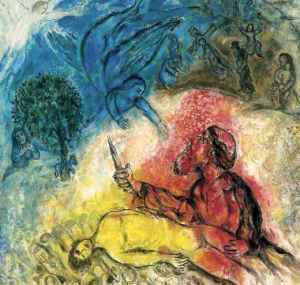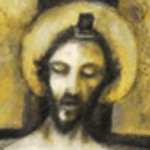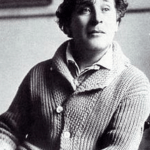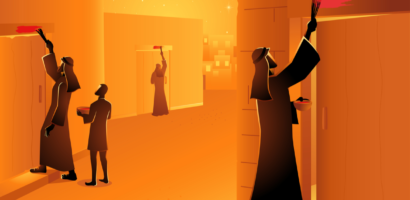Marc Zaharovich Chagall (1887 –1985) was a Russian artist associated with several major artistic styles, as well as one of the most successful artists of the 20th century. He was an early modernist who created works in virtually every artistic medium, including painting, book illustrations, stained glass, stage sets, ceramics, tapestries and fine art prints.
Art critic Robert Hughes referred to Chagall as, “the quintessential Jewish artist of the twentieth century.”
Using the medium of stained glass, Chagall produced windows for the cathedrals of Reims and Metz, the UN building in New York City and the Israeli Parliament (Knesset) building.
Before World Wa r I, Chagall traveled between St. Petersburg, Paris and Berlin. During this period he created his own mixture and style of modern art based on his understanding of Eastern European Jewish folk culture.
r I, Chagall traveled between St. Petersburg, Paris and Berlin. During this period he created his own mixture and style of modern art based on his understanding of Eastern European Jewish folk culture.
He spent the wartime years in Soviet Belarus, becoming one of the country’s most distinguished artists and a member of the modernist avante-garde, founding the Vitebsk Arts College before leaving again for Paris in 1922.
It is important that we view Chagall’s work in the context of Chagall’s life and circumstances. His hometown of Vitebsk had 60,000 inhabitants, almost split equally between Christians and Jews.
Coming from a Hasidic Jewish family that lived alongside religious Christians, Chagall struggled to r elate to Christian arguments about Jesus Christ and accusations made against the Jewish people. He visited Palestine under the British Mandate in early thirties, an event which was instrumental in inspiring his great passion for Biblical stories.
elate to Christian arguments about Jesus Christ and accusations made against the Jewish people. He visited Palestine under the British Mandate in early thirties, an event which was instrumental in inspiring his great passion for Biblical stories.
Crucifixion is considered a deeply painful symbol in the modern Jewish mind and it was probably so in Chagall’s day as well. His mixture of crucifixion alongside intimate Jewish symbols is viewed by some as disturbing. Chagall, however, saw the crucifixion of Jesus as a symbol of Jewish suffering, inflicted unjustly by gentiles upon Jews.
Jesus’ crucifixion is a common theme in Chagall’s work, but it is always the Jewish Jesus in the context of Jewish people. This is by no means an evangelistic attempt towards fellow Jews, it is rather Chagall’s defense of the Jews against the anti-semitism of many Christians in his local.
 It is also important to note that Marc Chagall was way ahead of “Third Quest for Historical Jesus” (scholarly movement) conducted later by New Testmament scholars that focused on the discovery of Jesus’ Jewishness.
It is also important to note that Marc Chagall was way ahead of “Third Quest for Historical Jesus” (scholarly movement) conducted later by New Testmament scholars that focused on the discovery of Jesus’ Jewishness.
In a great number of his works, Chagall combined elements of an often paradoxical and richly imaginative world with identifiable local and autobiographical elements. His compositions may simultaneously contain allusions to the Bible and to Jewish history, as well as references to contemporary reality.
For further discussion, see Aaron Rosen’s (a research fellow at Yale University Divinity School) work on White Crucifixion.
(Source www.abcgallary.com)
To receive more information about learning Biblical Languages with Hebrew University of Jerusalem/eTeacher Biblical program online at affordable cost, please, click here.
© By Eli Lizorkin-Eyzenberg, Ph.D.
To sign up for weekly posts by Dr. Eli, please, click here. It is recommend by Dr. Eli that you read everything from the begining in his study of John. You can do so by clicking here – “Samaritan-Jewish Commentary”.







This is a wonderful resourch to orientate in biblical visual art.
Visual Midrash from the TALI Education Fund Collections
In English:
http://www.tali-virtualmidrash.org.il/DefaultEng.aspx
In Hebrew:
http://www.tali-virtualmidrash.org.il/Default.aspx
Perhaps it is the written word the precipitation of the spoken image.
Eli,
Perhaps you can make it possible to place images in your blog?
Good material for study in the area jewish studies for Christians:
Drawing for the Bible _ Marc Chagall
Old Testament subjects are depicted in 136 works, 24 in full color: the creation, Adam and Eve, Cain and Abel, Hagar in the desert, the meeting of Ruth and Boaz, Job at prayer, more. Captions cite biblical sources of each drawing. Reprinted from a rare double issue of the French arts magazine Verve.
I’m trying to recall where I read a very good exposition of Chagall’s work recently. I tend to think it was in Time.
Either way, this is a very good focus on this mportant artist and the reflections on his work regarding the useof the crucifixion theme is a milestone to be reviewed in detail.
Thanks for bringing this subject to discussion.
If you are aware of other artists I should highlight that would be great. By the way if you would like to write a post on arts and theology that could fit here, I would welcome it and post it as a guest post on this blog. You are not really a guest, but this is technical vocab.
Hi,
Do you by any chance know the source for this statement,
Art critic Robert Hughes referred to Chagall as, “the quintessential Jewish artist of the twentieth century.”
I would so appreaciate it if you did.
Thank you,
Marti
050 885 1334
Marti, I looked for it all over the web for you, but could not find the exact reference by Robert Hughes.
Dear Dr Eli, Thank you for your reply. I wrote about “The Supremacy of Mind and Spirit Over Material Circumstances” The Spititual versus The Natural in 20th Century Jewish art. I wrote mostly about Jacob Kramer and Jacob Epstein. For some reason I did not write about the Crucifixion. I found from the research that Marc Chagall’s paintings were a mixture of him rebelling against his strict religious upbringing and seeking to come to terms with his new life of freedom in the West where it seems he felt more able to express himself with greater freedom. It appears he wanted to be seen as a universal artist as well as a Jewish one and looking back whilst also looking forward. As you mentioned in your article I also found that he tried to combine the imaginative and spiritual with reality.
good comments. Thank you.
This is the real source of Marc Chagall !
When I am finishing a picture, I hold some God-made object up to it – a rock, a flower, the branch of a tree or my hand – as a final test. If the painting stands up beside a thing man cannot make, the painting is authentic. If there’s a clash between the two, it’s bad art.
Marc Chagall
interesting.
I take it back. Its fascinating.
Ha ha Eli! You are on the right way ! Yes, it is really , really fascinating. Maybe we need art to come to a deep understanding of the fact that Jesus is the ‘Image’ of the Father ( 2 Cor. 4,4).
It’s not only the real source of Marc Chagall, Marc Chagall formulated here the real source of art. It’s nothing lesser than God Himself.
As an artist (not for research) I appreciate that you reserved a place for ART in your blog.
Arts and religion always have strong connections.
Remarkable by Marc Chagall is that he has often concentrated on the primary colors.
Christian painters often are doing so when they are focusing on the Try-unity.
My question to research artists in this blog is: is this in question by Marc Chagall?
On http://www.artnet.com/artists/marc-chagall you can find an overview of 27.961 works
to be from Marc Chagall. Of course a lot had to be claimed because when it is right he must created
almost one work a day. But this is true: his style is honored.
Can you give examples with thom this is so? (Trinity and colors)
Indeed art is probably the first witness to religion. In terms of human culture, artistic expression always comes before textual rendition. And even probably, textual renditions almost always takes its first clues from art expression rather than from oral tradition.
Art expression is a graphic representation of an idea whether religious, cultural, political or legal. Color follows the graphic language as a means to convey an important part of the message.
Art includes dance, rituals, burial customs, etc. so art reflects the beliefs of the living in an immediate way and almost always incorporates a direct translation in graphic images of very significant “testaments” about social life.
Dr Van der Berg opens a very interesting and promising area of study and research that longs for investigation. I hope he shares his thoughts and ideas on this very promising area.
Today we live in a world where the deep meaning of the image is often forgotten. See and hear go in advance to the written word. A large part of the Bible consists of visions, dreams, images and symbols. The origin of the written word we can see also in the Hebrew alphabet. All the letters have their origin in images: door, hook, eye , etc. We have an image of God. an image of life, a self-image. What we can ‘t say with thousands of words, we can say with an image. God showed the model of the temple to Moses. First was the picture, then the description. Prophetic acts were often images. I think that we can’t fully understand the deep sense of God’s revelation without a deep understanding of the visual language . Images are speaking thousands and ten thousands words.
Psalm 19, 1-4 : ‘ The heavens declare the glory of God ; and the firmament ‘shows’ and proclaims His handiwork . Day after day pours forth speech , and night after night ‘shows’ forth knowledge;
their ‘voice is not heard’ . Yet their (in evidence) goes out through all the earth , their sayings to the end of the world .’ That is the power of the image. Maybe that ‘s the source of the word ?? The is the deep sense here:
John 1: 18 : ‘ No man has ever ‘seen’God , but God the One and Only, who is at the Father’s side , has made Him ‘ known’. John 8:38 ‘ I tell (speak) the things , which I have ‘seen’ at My Father’s side’.
Gen. 1:27 ‘God created man in His ‘image’….
very helpful.
Indeed, even from its beginning, the Bible reads as a textual depiction of a story or various intertwined stories that share common elements of rituals and “religious performances” that convey the relation of man and God in a specific way. If we read carefully, the acts or actions, the symbols, the description of space and activities, the places, etc., all in all maybe taken as a kind of artistic expression of communication between human beings and God or godly representatives.
Action then is and becomes art and then it becomes oral tradition and then artistic ideas writing and writing becomes text. We are then “reading” artistic expressions that we term religious actions which in the end we define as religion by itself. But in the beginning, it was pure art. And it still is.
Maybe our quest is to restore the artistic sense of the text in order to better understand the meaning of the religion.
Ramon, as always I learn a lot from your comments. Thank you.
Today we live in a world where the deep meaning of the image is often forgotten. See and hear go in advance to the written word. A large part of the Bible consists of visions, dreams, images and symbols. The origin of the written word we can see also in the Hebrew alphabet. All the letters have their origin in images: door, hook, eye , etc. We have an image of God. an image of life, a self-image. What we can ‘t say with thousands of words, we can say with an image. God showed the model of the temple to Moses. First was the picture, then the description. Prophetic acts were often images. I think that we can’t fully understand the deep sense of God’s revelation without a deep understanding of the visual language . Images are speaking thousands and ten thousands words.
Psalm 19, 1-4 : ‘ The heavens declare the glory of God ; and the firmament ‘shows’ and proclaims His handiwork . Day after day pours forth speech , and night after night ‘shows’ forth knowledge;
their ‘voice is not heard’ . Yet their (in evidence) goes out through all the earth , their sayings to the end of the world .’ That is the power of the image. Maybe that ‘s the source of the word ?? The is the deep sense here:
John 1: 18 : ‘ No man has ever ‘seen’God , but God the One and Only, who is at the Father’s side , has made Him ‘ known’. John 8:38 ‘ I tell (speak) the things , which I have ‘seen’ at My Father’s side’.
Gen. 1:27 ‘God created man in His ‘image’….
Thank you for this blog, I am an artist and I researched and wrote about Marc Chagall along with Jacob Epstein and Jacob Kramer for my final year dissertation at uni. It was interesting to read more about his thoughts and motivations for his paintings of the crucifixion.
Dear Carolyn, I would love (and I am sure other readers of the blog) to hear the findings of your research. Feel free to contribute to the discussion.